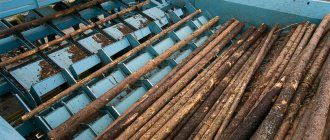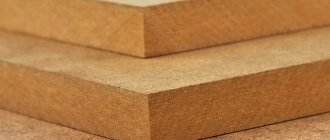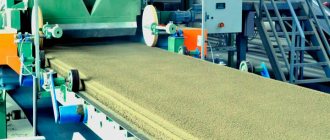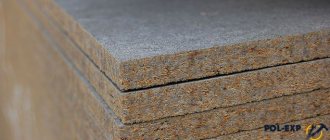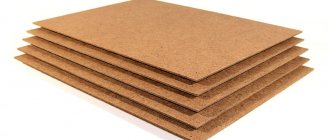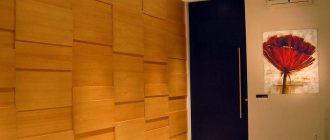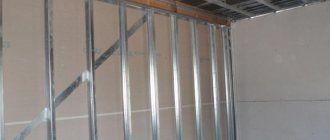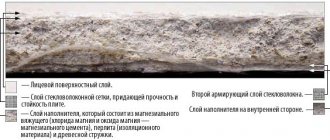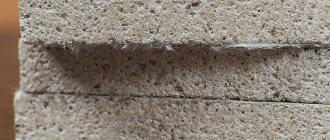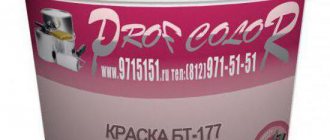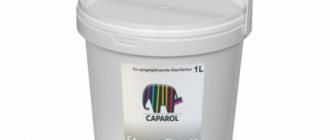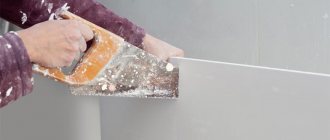I want to build a country house using frame technology. I came across this table:
Comparison of DSP with OSB
Does anyone know anything about DSP? Can this data be trusted? I was very excited about technology. Talk me out of it, please!
sip panels DSP In the photo it looks so much more solid than wood!
I continue. What you are asking about CSP (cement particle board) has nothing directly to do with this method. Unless it would be nice to clad the house with this slab and then paint it. Those pictures that you have at the beginning of the story are not DSP. The pictures show a PANEL assembled at the factory from two facing slabs (which does not matter) and internal insulation, say, cellular polystyrene foam or similar insulation. As a cladding made of painted DSP, this is a good and durable solution. I see it in the example of my relatives’ dachas. Photo number one.
In the second photo you see in the background the skeleton of a frame house before being filled with a very decent heat insulator produced by the TechnoNIKOL company. In your lower photo we see the process of installing a PANEL house. It has nothing to do with frame house technology. And another extremely important aspect. The thermal insulators used in such panels are good thermal barriers, but they are practically not breathable. What does it mean? Yes, the walls in such a house “don’t breathe.” What will the happy new settlers breathe then? This only means that the design of your house must include a supply and exhaust ventilation system. I sincerely wish you good luck in preparing the project. I can provide you with conceptual technical articles on this topic, specially tailored for our wonderful summer residents. In conclusion, I will return to your question again. Pictures of panels (three) are not an illustration of the technical data provided. Please don't confuse this. Facing - DSP
Frame house
In the lower photo of the author, the installation of a SIP house from SIP panels from DSP. It is directly related to the technology of frame construction. Of course, this is not a classic frame, but still a frame. SIP panels can also be mounted on a monolithic frame, but in this case, the frame is wooden. OSB does not have a single characteristic, other than weight, that would be superior to DSP. The most important thing is that DSP (unlike OSB) is not susceptible to mold and mildew, and is also indifferent to moisture. God forbid that an OSB house floods and is not promptly dried. The fungus is guaranteed, and as a result, the repair is a mess + an unpleasant smell. They also say that osb is not environmentally friendly, but this is for the suspicious). Also, when building from DSP, walls can be painted immediately or wallpaper can be glued. Compared to OSB, significant savings.
Ventilation is of course necessary... but it is needed in any home! Brick houses have holes, so they are breathable)) They need to be insulated, and as a result they will become the same non-breathable thermos. If you make repairs or decorate the facade, no one will know what technology the house was made of, but you will pay pennies for heating and save money on construction.
Floor, external and internal walls made of SIP panels based on DSP
Cement particle boards (CPB) are not a new building material; their production in Russia has been carried out since 1980. However, in recent years, the demand for this finishing material has increased sharply. This is due to the rapid growth of low-rise construction, since the DSP board, reviews of which are presented in this article, is most popular among private developers.
This popularity is explained simply: DSP boards have an affordable price, various thicknesses, a pleasant appearance without flaws and a relatively light weight, convenient for self-assembly of one-story houses.
Most of the slabs have a natural gray or brown color, but in some cases a colored layer of fine dust or natural stone chips is sprayed onto their surface. Thanks to this, the facades look very attractive and unusual.
Main features of CBPB boards
Despite the fact that this finishing material appeared in the USSR only in 1980, in the USA it has been actively used since the 30s of the last century. There the composition of the material was developed, its use was tested as finishing materials for facades, as well as as formwork when pouring load-bearing structures made of cement.
This material is made from wood chips of various sizes, M500 cement and a number of chemical additives, which increase the adhesion of the component components of the product.
What is DSP
From the name itself it already becomes clear that this finishing material is made from:
- Portland cement – 65%;
- wood shavings – 24%;
- additives (2.5%), which protect cement from the negative effects of wood extracts (most often liquid glass is added);
- water – 8.5%.
The material is made in the form of plates by pressing, hence the high density (1300-1500 kg/m?). You can buy slabs of different thicknesses from 8-36 mm on the market. For external finishing with DSP boards for private housing construction, panels with a thickness of 10-16 mm are used. The sizes of the slabs vary from 1250x2600 mm to 1250x3200 mm.
Advantages
- DSP panels are not afraid of moisture. Testing has shown that this material can last 24 hours in water and still swell by only 2 mm.
- Highest sound insulation.
- Increased strength. It’s impossible to break a slab just like that; you’ll have to try hard.
- Although this material is classified as flammability category G1, its flammability itself is zero. When heated strongly, it does not emit toxic gases or smoke.
- Good vapor permeability, so houses lined with DSP “breathe.”
- This finish is not eaten by rodents, and colonies of fungi and mold do not form on it.
- Service life – 50 years.
- DSP panels are paintable slabs, so it is possible to design the facade of the house exactly to match the landscape design of the site.
Advice! Currently, DSP panels have appeared on the market that accurately imitate brickwork and decorative plaster. Some models are covered with marble chips. They have higher performance characteristics. Experts recommend paying attention to them.
Flaws
- Cement particle boards have a fairly large specific gravity. And if it is still possible to clad the first floor with them somehow, then raising a three-meter panel higher is, firstly, inconvenient, and secondly, difficult. To carry out this stage with your own hands, you need to invite helpers.
- Panels of small thickness may break if taken by the edges along their length. Therefore, when working with them you need to be very careful, especially during the unloading process.
- DSP boards have a high hardness level, so cutting them manually with a hacksaw or other similar tool is long and tedious. To do this, it is best to use a grinder with a disc for concrete or stone.
- Quite a large thermal expansion, which leads to cracking of the gaps between the plates. They are usually sealed with putty or plaster. But this problem has its own solutions, which will be discussed below.
DSP facades: advantages and disadvantages
Cement building boards, when used as facades, have a number of advantages:
- have high strength;
- tolerate moisture well and are resistant to rotting;
- resistant to fire for 50 minutes;
- They are a bioresistant material (mold and mildew do not grow on them);
- perfectly cut off external sounds;
- Compared to its main competitors, they have high safety characteristics;
- feel great during ultra-low temperatures;
- have low thermal conductivity.
Features of installing DSP on facades
The DSP board, reviews of which are presented below, is mounted on a frame prepared in advance. I use long self-tapping screws as fasteners. Insulation should be provided between the wall of the house and the facade. Due to the fact that cement particle board is a fairly heavy material, it must be secured at least at three points.
A gap of up to 8mm wide should be provided between the plates. This need is dictated by the fact that during high humidity the slab can diverge, increasing or decreasing.
Such a gap will help to avoid bulging. For the same reason, you should not seal the resulting seams with finishing materials such as putty and cement mortar.
Reviews about CBPB boards
About such a finishing material as DSP board, reviews from owners of private houses characterize it as a material that lives up to expectations and is quite worthy of the money spent on its purchase. Below are some reviews from people who have used it as a finishing material.
- “My foam house is lined with DSP inside and out. The outer side is painted with facade water-based paint - it holds up perfectly. Inside, wallpaper is pasted onto the walls directly onto cement-bonded particle boards—everything is great, too. I attached the slabs directly to the wall; however, I placed additional wind and moisture film on the front side. It takes two people to fasten the slabs, as they are heavy. For sawing you need a stone grinder.”
- “My facades are covered with DSP. I should note that during fastening, chips may form, since the material is quite fragile, and therefore you should tighten the screw heads very carefully.”
- “They consider the fact that the external walls have to be puttied and plastered as a disadvantage. When humidity and temperature fluctuations occur, the seams burst, so the only option to hide this defect is to cover it with slats.”
- “If the appearance of the slabs bothers you, you can decorate the walls with siding or simply paint them with facade paint, it will turn out cheap and cheerful.”
- “I covered the facades with DSP slabs and got problems with the seams. However, I understood that these problems are characteristic of all slab materials, and therefore I was ready for this. At first I puttyed it, but it only helped for a while, so later I covered all the seams with decorative strips. Everything is great now. And yet, there is no need to plaster the slabs themselves, there is absolutely no point in this, it’s enough just to paint them to protect them from moisture.”
See more on this topic on our website:
- OSB board - technical characteristics, application in private frame construction This article provides information about a material such as OSB board: technical characteristics, application, advantages and disadvantages. OSB panels have several names: OSB, OSB, OSB, a.
SML glass-magnesium sheets - reviews on use in finishing facades Glass-magnesium sheets are an excellent choice for rough finishing of facades. Facades made from SML sheets are used in the construction of residential complexes, industrial buildings, retail premises, industrial buildings, etc.
ISOBEL insulation technical characteristics and reviews from home owners ISOBEL insulation is a new productive material that is produced using innovative technologies using the latest foreign-made equipment. It is created on the basis of mountain basalt rocks. Insulation ISOBEL.
Glass-magnesium sheet - technical characteristics, application in house facades Glass-magnesium sheet was invented not so long ago, but it very quickly gained recognition from builders all over the world. It is used as a replacement for drywall and blocks.
OSB board - characteristics, reviews, application in facade work The article provides an overview of such a material as OSB board, characteristics and reviews of this material. OSB (OSB) board is an abbreviation for the English words Orient Strand Board.
One review on “DSP board - reviews on use in facades of private houses”
Cons: heavy, relatively fragile and not moisture-resistant material.
Pros - does not burn, relatively durable with a thickness of 16 mm on walls and 22 mm on ceilings, relatively cheap.
How to install slabs
The DSP facade can be installed as a suspended ventilated facade with or without insulation. But professionals recommend using an insulating layer regardless of the weather conditions of the region. It helps protect not only from severe frosts, but also from sweltering heat.
There is also an option for a frame-panel house building system, as in the picture below.
The frame for the ventilation facade is mounted from wooden blocks treated with an antiseptic, or from a metal profile. The second option, of course, is preferable, since it will last a very long time, and manufacturers guarantee that the DSP finish will last no less than 50 years.
The frame strips can be mounted both horizontally and vertically. Here you need to focus on how the façade panels will be installed. If the DSP board is mounted horizontally, then the frame is made vertical and vice versa. The step between the planks is no more than 60 cm. During the fastening process, you should periodically check with a level and plumb line whether all the planks are installed evenly.
After the frame is constructed, insulation and a hydraulic barrier should be installed. They are fixed with a mushroom dowel at a rate of 5 per square meter, with 2 securing the insulation, and the remaining 3 - the hydrobarrier and insulation together.
Now you can begin installing the DSP on the facades, but you must leave a ventilation gap between the slab and the waterproofing membrane of at least 2 cm. The panels are attached with 3 fasteners to each frame strip with which they come into contact. This will be the most reliable way.
Holes for self-tapping screws must first be made on the ground, since the material is very hard. A small distance of approximately 3–5 mm should be left between the DSP; this is necessary for the expansion of the material when heated. It is best to seal these seams with sealant. This substance is elastic and will not crack like putty or cement mortar. Another option is to insert a polyethylene foam cord there, as in the picture below.
After all the panels are attached and the seams are sealed, finishing the DSP facade still cannot be considered complete. Conventional slabs, although smooth, have a gray, unpresentable appearance. In order to diversify it, you can use facade paint for concrete.
Before applying the dye, you need to deepen the screws a little, and fill these recesses with putty and lightly sand the rough surface. In addition, the joints can be covered with metal or wooden strips and painted in a contrasting color. This method of finishing will be unusual and interesting.
Manufacturers also produce decorative versions of cement-bonded particle boards for exterior finishing. The front surface may have a layer applied that imitates brick or stonework, or the surface may be completely strewn with marble chips of various colors.
A house whose exterior is lined with cement particle boards will be reliable in any corner of the world, since it has acquired the advantages of cement: it does not rot, does not burn, and does not freeze.
Detailed video instructions for installing DSP boards and further finishing.
DSP - a little about the material
Cement particle board is a multilayer sheet material. The raw materials for production are crushed wood shavings and cement. Reagents are added to the molding mass to increase service life and resistance to external influences.
The material is multi-layered - the outer layers contain small chips, the inner layers contain larger ones. The result is a perfectly smooth slab, which facilitates finishing work.
The production of CBPB requires special industrial equipment and is only possible in a factory environment.
Here are 5 main advantages that bring CBPB into the line of popular building materials:
- manufacturers claim a guaranteed service life of at least 70 years even when opened;
- slabs require minimal finishing inside and outside;
- wide scope of application - flat roofs, flooring, wall cladding inside and outside;
- fast and convenient installation;
- fire resistance.
All these advantages have led to the fact that cement-bonded products have become not only a material for the base of flat roofs, flooring and other construction work, but also a common option for frame construction.
In addition to the listed advantages, the reasons for the popularity of fiberboard in house construction are resistance to moisture, rot, and fungus. This building material does not attract insects and rodents, and does not deform like wood.
Advantages and disadvantages of application
Like any material, DSP, despite its undeniable advantages, also has some disadvantages; let’s take a closer look at the pros and cons of DSP panels, the characteristics of which were given above. The advantages of the material include the following properties:
- High strength;
- DSP sheets, even with a small thickness, provide a high degree of sound insulation;
- Cement particle board does not burn even at very high temperatures;
- Even without additional processing, it has antiseptic characteristics;
- Vapor permeability;
- Water resistance.
The disadvantages of the material are less significant:
- Large specific gravity of the slab, making installation work difficult;
- Insufficient strength under bending loads;
- Difficulty in cutting and increased and large amounts of dust when cutting with power tools;
In order to draw final conclusions, it will be useful to study reviews on the Internet; here are some of them.
What foundation is suitable for a frame frame with DSP cladding?
A frame house with DSP cladding is lightweight compared to a brick or block house (gas, foam and slag concrete). Therefore, the choice of foundations for it is wide.
To avoid making mistakes, you should be guided by:
- the total weight of the house (find it out from the design documentation);
- winter snow load;
- the type of soil on the site where development is planned;
- personal preferences.
Let's decipher the last point. If you want a full-fledged basement, choose a recessed strip foundation; if you want to save money, choose a combined one (bored with a grillage) or a pile. Some unscrupulous developers are trying to say that a pile-screw foundation is not suitable for frame houses sheathed with DSP. Don't believe it - this is an attempt to get more money.
A house made of fiberboard - construction nuances
Any building material requires a special approach. There are nuances in working with cement-bonded particle board.
- The first and most often mentioned is fragility. Despite their high strength and ability to withstand loads in operating mode, such products easily break under their own weight when trying to lift them incorrectly. For installation, you need to use a winch or lift it manually using a rope with a block. When lifted, the sheet is positioned vertically, in this case there will be no annoying surprises. For skeptics: after installation on a frame made using technology, the cladding no longer behaves in this way. The level of structural rigidity is high and no fragility is observed.
- Place of installation of fasteners. Those who build such houses on their own use different types of hardware - galvanized nails (with pre-drilling), self-tapping screws of sufficient length (galvanized or brass with a countersunk head), and screws. It is important not to screw in self-tapping screws or drive nails close to the edge of the slab (no closer than 1 cm), this can lead to the edge breaking off and, as a consequence, insufficient fixation in certain areas.
- Seams between products. DSP contains wood chips and is capable of changing dimensions due to changes in humidity and temperature. Between the elements, a technical seam of at least 3 mm is required (for large slabs - at least 5 mm indoors, 8 mm outdoors). If you sew the material end-to-end, the walls may become deformed.
- Installation of finishing materials outside. The slab made of cement and wood chips is perfectly smooth. At first glance, this is good, but when you try to apply plaster solutions to the surface, you may encounter insufficient adhesion. In simple words, applied solutions do not last after drying. Here it is worth using a special primer (Betacontact) and attaching a reinforcing mesh. The same algorithm of actions is useful when laying tiles on the surface.
To get a high-quality result, it is better to entrust the construction to an experienced team of assemblers. Building a frame house from DSP with your own hands is not easy, especially if it has more than one floor.
Use in construction: pros and cons
The main limitation in the use of cement bonded particle boards is their high specific gravity. With equal sizes, they are at least twice as inferior to chipboard and other sheet building materials in this regard. The use of DSP automatically implies an increase in the load on the foundation and supporting structures, an increase in requirements for the reliability of the frame and fasteners, and difficulties in transporting them to the upper areas. One medium-thick slab weighs at least 80 kg; installation by one person is impossible, as is lifting to the second floor without scaffolding and winches.
Cutting and further processing are possible at home, but you should be prepared for the formation of dust. DSPs are abrasive materials with strength characteristics similar to dense wood; such purposes imply the use of tools with high rotation speeds and hard working surfaces. On the other hand, according to reviews, there are no problems with drilling, fastening and subsequent finishing; the edges when cutting are neat in any case.
Overall, the advantages outweigh the disadvantages. The advantages include:
- Environmental safety.
- Versatility and multifunctionality.
- Compliance with fire safety standards: flame does not spread across the surface of the DSP, the material does not emit smoke and toxic substances when exposed to high temperatures, the fire resistance limit is 50 minutes.
- Long term maintenance-free operation; under normal conditions, durability reaches 50 years.
- Geometric accuracy of shapes. These products are certified; the dimensional characteristics of cement particle boards are controlled by GOST. Stability of shapes is maintained throughout the entire service life; DSPs are not afraid of UV or temperature changes. Fracture is possible only when installed on an uneven surface.
- Independence from climatic conditions.
- Good insulating properties, applications include multi-layer structures.
- Resistant to moisture and rot.
- Vapor permeability allowing you to breathe.
Recommendations for selection and purchase
The main criterion is the thickness of the slabs; it is selected taking into account their intended purpose. In particular, the recommended limit for different building structures is, mm:
- When installing formwork - 12-24.
- The slabs for cladding facades and interior wall decoration are 10, 12 and 16.
- When constructing moisture-resistant partitions - 12 and 16.
- Using DSP as a window sill – from 24.
- When using floor slabs (rough, base for other building materials, leveling layer or finishing) - from 8 to 24.
The higher the expected loads (including humidity), the thicker the DSP is needed. At the same time, an increase in this size characteristic leads to an inevitable increase in weight, which is not always acceptable. This also applies to the cost of material: prices for chipboards of various sizes, but the same in area, vary from 600 to 2,500 rubles with a thickness of 8 and 36 mm, respectively.
The next factor to be taken into account is the type of surface of the slabs; plaster fits equally well on both embossed and smooth varieties, but when painting, the use of the latter is preferable. Textured DSPs are optimal for interior decorative finishing. Attention is drawn to the compliance of the characteristics of the board with GOST; in this regard, it is better not to take risks and purchase products from trusted manufacturers. Products from Russian factories Tamak (Tambov), TsSP-Svir (St. Petersburg), Stropan (Omsk), MTI CJSC (Kostroma), Sterlitamak (Bashkorstan) have positive reviews. Their price offers are almost the same; the final cost is affected by the proximity of the warehouse and the volume of purchases.
Myths about building with cement bonded particle board
On the forums of developers and lovers of building houses with their own hands, there are a great many opinions about residential buildings sheathed with DSP. There are positive reviews and there are negative ones. As usual, most negative reviews are related to violations of construction technology. Here are three main myths that we will now debunk.
- A house made of fiberboard does not retain heat well. This erroneous opinion is due to the fact that frame frames sheathed with OSB are advertised by construction companies as warm, arguing that the heat-saving properties are based on the characteristics of the wood. DSPs consist not only of wood chips, but also of Portland cement; according to amateurs, this makes the house less warm. If you build a building and use OSB as cladding without insulating the space between the walls in any way, its heat-saving qualities will not be higher when creating the same box from DSP. Heat conservation occurs due to a well-assembled wall “pie”. There is insulation, vapor barrier, and wind protection. A properly built house made of fiberboard with a frame is not inferior in heat-saving properties to a building sheathed with OSB or other sheet materials.
- The use of cement-bonded particle boards makes the structure heavier, so you need to choose massive, powerful foundations. Some development companies convince their clients that a screw or other lightweight type of foundation cannot be used for such a frame. Often this is an attempt to earn more money, because the type of foundation depends not on the cladding material, but on the weight of the building and the soil at the construction site. The best way to determine whether a pile, strip or slab foundation is suitable for you is to order a geodetic study (soil type, occurrence of groundwater plates) and calculate the foundation based on the design documentation. The engineering section of the project indicates the weight of the building and the total load on the foundation.
- The walls of the house crack in summer and winter due to the compression and expansion of the slabs. The influence of moisture on the volume of CBPB cannot be completely denied. The material contains wood shavings, which, albeit in small quantities, absorb moisture. But if the construction technology is followed, the wall will not deform, and to avoid cracks, it is important to choose the right finishing material.
Installation
Before installing the panels for cladding the foundation, you should prepare the surface of the plinth:
- The first step is to remove the previous coating of the base (if it is high-quality plaster, then you can leave it);
- Then we conduct an inspection and treat with antiseptics, thereby destroying the existing fungus or preventing its appearance in the future;
- Next, using a brush or spray gun, apply an even layer of primer. After all this, you should install a frame to which our panels will be attached. There are two types of frames - wooden and metal. Both options are good, but the second, unlike the first, is not subject to rotting and, therefore, will last much longer. If you choose the first option, then for reliability, treat the wooden structure with antiseptics - this will extend its service life, and, therefore, the facade plinth panels will also last longer;
- This should be done correctly and carefully - incorrectly installed façade panels for the foundation will not last long.
Installation of sheathing
Markings should be made so that the plinth cladding panels are perpendicular to the ground at the top, otherwise the stone plinth panels will look bad.
When you mark, you need to take into account the dew point and draw a line so that the panels overlap this very point.
The dew point is the floor level and it must be covered to prevent the accumulation of condensation, otherwise the whole point of finishing will be lost
The important thing is that the dew point should be covered at least ten centimeters higher
After marking is applied on one side of the house, it should be evenly transferred to the other. A hydraulic level can help you with this (you can easily purchase it at a hardware store or make it yourself by finding instructions on the Internet).
Next, you should cut the material to the required size and begin to attach it strictly along the line, thereby creating a starting bar. For fastening to a wooden wall, you should use self-tapping screws, but if the wall is concrete or brick, then dowels will come in handy, for which you will need to make holes of the required size with a hammer drill. It is recommended to install the first line 110mm from the edge so that there are no problems with installing corner elements.
It should be noted that the frame for finishing the foundation must be firmly attached and for this it will be better to use dowels not from kits, but separate ones - self-tapping screws and plastic parts purchased separately, and the screws should have a cross-section a couple of mm larger than plastic, only in this case good quality of fastening can be guaranteed.
- Having established the lower contour, you should work on the transverse one. The connection should be made on the profile, and not on weight, so you need to take into account the dimensions and make markings.
- Afterwards, we cut the material and fasten it using the previously described method. The height can be adjusted using spacers.
- Next, having installed the sheathing, you need to install the insulation, having previously applied a layer of waterproofing.
Installation of plinth panels
Next comes the finishing process of the base under the stone. Finishing the foundation with panels should be done carefully and strictly on the frame.
Initial stage: in the corners we attach the elements to which the panels will be mounted. PVC panels are attached only in a vertical position, so when making calculations you need to proceed from this. Also, you can pay attention to DSP panels, because they can last much longer, unlike PVC. You should attach cement-bonded particle boards or PVC strictly from left to right (if you have more than one panel, then from bottom to top). Before finishing the first element, do not take on the next one - this is important. The finishing of the plinth with panels must be done using measuring tools. It’s worth measuring everything in advance so as not to spoil the appearance of your private home. A small gap should be left between the panels so that cracks do not appear when the materials expand under the influence of weather conditions. Also, do not secure the plinth panels rigidly with fasteners, otherwise cracks will form due to temperature changes. The panels must be fastened at at least five points. Fasteners must be strictly at an angle of 90° relative to the slab.
What types of finishes are suitable?
Those who have already dealt with cement particle boards talked about the difficulties in finishing. There are no particular difficulties at this stage of construction, you just need to know about the features of DSP, this will help you figure out what material to use for finishing inside and outside.
The slab has a low level of hygroscopicity and adhesion - to apply layers of plaster or putty you will need a special primer and reinforcing mesh. The seams should be filled with elastic plaster or covered with decorative elements.
Interior decoration
Interior decoration depends on the interior style you choose. DSP are smooth panels that can be easily painted or applied with decorative textured paints and putties. It is important to fill the seams correctly so that they do not crack, and to choose a composition for application to the wall surface.
The simplest and most cost-effective finishing method is painting with preliminary filling of the seams with acrylic sealant (displacement coefficient 7.5%), sealing them with a non-woven construction bandage and leveling them with putty.
If you are still worried about possible cracks, there is a more expensive but reliable method. It is necessary to sew up the gypsum board walls in one layer without lathing (after all, the slab is smooth, there is no need to level the surface). After this, any coating can easily be placed on the wall. The same method is suitable for bathrooms and toilets where ceramic tiles are planned.
Without preliminary preparation (economy class), you can purchase thick vinyl wallpaper for painting and paste it on the walls. They have the ability to stretch and compress, so the movement of the slabs under the influence of changes in humidity will be completely leveled.
Exterior decoration of the house
The most common way to finish a DSP frame is to imitate half-timbering . The seams are securely hidden behind the slats, and the main area is covered with paintwork of the selected color. But not everyone likes the style itself.
- Application of elastic paint. The method is convenient and reliably prevents the appearance of cracks. The downside is the high cost, especially in turnkey configurations from developers offering the construction of houses.
- Using elastic mastics to fill seams for further painting. Acrylate enamels for exterior use and organic solvent paints are used as the main coating.
- Ventilated façade. The minus is a large-scale complex of works, the plus is the attractive appearance of the facade, a long service life without repairs and maintenance.
- Sheathing with siding and other sheet materials. It is rational if in your region there is a possibility of a strong drop in temperature in winter. An additional thermal insulation layer with wind protection can be installed under the cladding. Disadvantage: high cost, large-scale work package.
To briefly summarize, we get the following facts. A frame house covered with cement particle boards is a strong and durable home without the need for frequent repairs. Easily withstands low temperatures, changes in humidity, does not rot, is not flammable, and is not susceptible to damage by insects and rodents. Technologically, the material provides ample opportunities in the choice of finishing materials. The only difficulty is to find a conscientious developer who will erect the building exactly according to the technology, without mistakes or hackwork, and only in this case the building will be able to show all its positive qualities.
- Author: Maria Sukhorukikh
Rate this article:
- 5
- 4
- 3
- 2
- 1
(0 votes, average: 0 out of 5)
Share with your friends!
